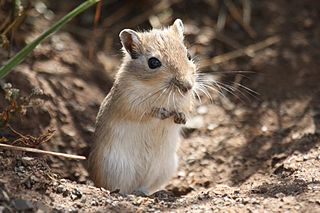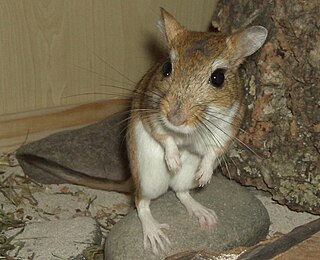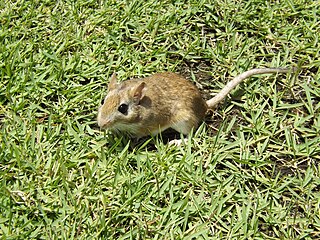
The Mongolian gerbil or Mongolian jird is a rodent belonging to the subfamily Gerbillinae. Their body size is typically 110–135 mm, with a 95–120 mm tail, and body weight 60–130 g, with adult males larger than females. The animal is used in science and research or kept as a small house pet. Their use in science dates back to the latter half of the 19th century, but they only started to be kept as pets in the English-speaking world after 1954, when they were brought to the United States. However, their use in scientific research has fallen out of favor.

Gerbillinae is one of the subfamilies of the rodent family Muridae and includes the gerbils, jirds, and sand rats. Once known as desert rats, the subfamily includes about 110 species of African, Indian, and Asian rodents, including sand rats and jirds, all of which are adapted to arid habitats. Most are primarily active during the day, making them diurnal, and almost all are omnivorous.

The genus Allactaga contains the five-toed jerboas of Asia. They are small mammals belonging to the order of rodents. They are characteristically known as the hopping rodents of the desert and semi-arid regions. They have long hind feet, short forelimbs, and walk upright. They have large ears in comparison to their body size and a large tail. The tail assists and serves as support when the jerboa is standing upright. The jerboa body length ranges from 5–15 cm and has a tail ranging from 7–25 cm. The "forelimbs of the jerboa serve as a pair of hands for feeding, grooming, etc." Jerboas use their nose to burrow and push the dirt when looking for food. The male jerboa is usually larger in size and weight in comparison to the female jerboa. The pelt of the jerboa is either silky or velvety in texture and light in color, the coloration helps camouflage into surroundings to avoid predators. All members of the genus have five toes.
Przewalski's gerbil or Przewalski's jird is a species of rodent in the family Muridae. It is the only species in the genus Brachiones, and is found only in China.
Sokolov's dwarf hamster is a species of rodent in the hamster and vole family Cricetidae. Previously listed as conspecific with Chinese striped hamster, it has been listed as a separate species since 1988. It has a distinctive dark stripe down its back on and otherwise grey body. It is found in China and Mongolia, and lives in burrows beneath desert shrubs.
The Namib brush-tailed gerbil or Setzer's hairy-footed gerbil is a species of rodent endemic to Angola and Namibia. Its natural habitats are sandy and gravelly plains. It stays in its burrow by day, emerging at night to feed on arthropods, vegetable matter, and seeds.

The Arabian jird is a species of rodent in the family Muridae. It is found in Oman, Saudi Arabia and United Arab Emirates.
Cheng's jird is a species of rodent in the family Muridae. It was named in honour of the Chinese zoologist Professor Tso-hsin Cheng. It is found only in the Turpan Depression of eastern Xinjiang, China.

Sundevall's jird is a species of rodent in the family of Muridae. It is found in Afghanistan, Algeria, Egypt, Iran, Iraq, Israel, Jordan, Kuwait, Libya, Pakistan, Morocco, Niger, Palestine, Oman, Saudi Arabia, Sudan, Syria, Tunisia, Turkey, Western Sahara, United Arab Emirates, Bahrain and possibly Mali. Its natural habitat is hot deserts.
Dahl's jird is a species of rodent in the family Muridae. It is found only in Armenia and the neighboring Agri province of Turkey.

The Libyan jird is a species of rodent in the family Muridae. It is found in Mauritania, Morocco, Algeria, Tunisia, Libya, Egypt, Jordan, Syria, Saudi Arabia, Iran, Iraq, Afghanistan, Turkmenistan, Uzbekistan, Kazakhstan and Western China. Its natural habitats are subtropical or tropical dry shrubland, intermittent saline lakes, hot deserts, and rural gardens.

The Persian jird is a species of rodent in the family Muridae found in Afghanistan, Armenia, Azerbaijan, Iran, Iraq, Pakistan, Saudi Arabia, Turkey and Turkmenistan.
The king jird is a species of rodent in the family Muridae. It is found in Saudi Arabia and Yemen.

The tamarisk jird or tamarisk gerbil is a species of rodent in the family Muridae. It is found in China, Mongolia, Kazakhstan, Kyrgyzstan, Russia, Turkmenistan, and Uzbekistan. It prefers habitats with grass or shrub cover.

Tristram's jird is a species of rodent that lives in the Middle East. It is named after the Reverend Henry Baker Tristram who collected the first specimens. It is up to 155 mm (6.1 in) long, and lives in burrows in steppes and semi-deserts from Turkey and the Caucasus to Israel and Iran. Records from the Greek island of Kos represent the only gerbils reported from Europe, outside the former Soviet Union. It is a common, widespread species, and is not considered to be threatened.
Vinogradov's jird is a species of rodent in the family Muridae. It is found in Armenia, Azerbaijan, Iran, Syria, and Turkey.
Zarudny's jird is a species of rodent in the family Muridae. It is found in Afghanistan, Iran, and Turkmenistan.

The northern three-toed jerboa is a species of rodent in the family Dipodidae. It is the only extant species within the genus Dipus. It ranges across Iran, Uzbekistan, Turkmenistan, Kazakhstan, Russia, China and Mongolia. A common species, the International Union for Conservation of Nature rates it as being of "least concern".
The Moroccan jird is a species of rodent from the family Muridae. The species was first described by Ángel Cabrera in 1907. It is endemic to Morocco, northern Algeria, and Tunisia. It had been included as part of Shaw's jird, but was considered in 2000 to be a separate species.










